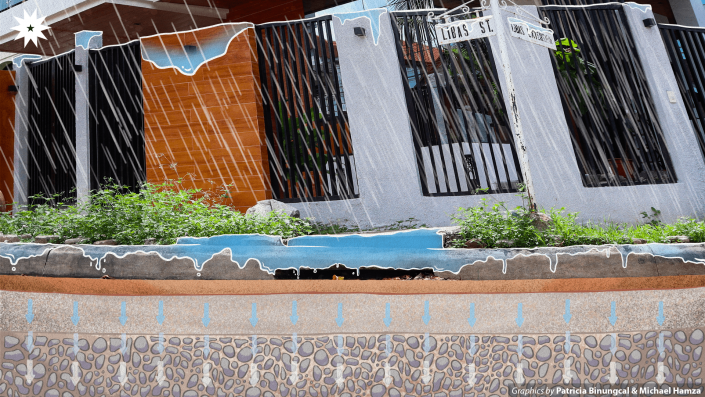The Philippines is no stranger to tropical storms and flash floods. Ranked as the second country with the most annual tropical cyclones, the country experiences a yearly average of about four tropical storms—just below China’s 6.714 average.
Due to these conditions, many Filipinos have lost their homes, livelihoods, and loved ones throughout the years. And these storms’ severity is also increasing due to the rise in prominence of global warming.
In order to solve the country’s large-scale storm and flooding problem, new perspectives and solutions may be needed—ones that take inspiration from nature rather than doubling down on existing flood prevention systems.

Draining away the problem
As urbanization rapidly expands across the country, permeable surfaces that absorb rainfall are covered by roads and buildings, preventing infiltration and increasing the severity of floods. Moreover, urbanization brings about an increase in greenhouse gas emissions from vehicles as well as the creation of the “heat island effect”—a phenomenon where temperatures increase in urban areas due to concrete structures absorbing and reemitting more heat. Higher temperatures, in turn, increase evaporation rates that cause an increase in the formation of storm clouds.
To combat this, engineers have created what is known as low-impact development solutions (LIDs). Civil Engineer Sergi Garbanzos describes these as an “integration of the main aspects of urban water management, aimed to treat all sources of water in a catchment as a resource.” These solutions introduce permeability back into the impermeable to decrease floods and pollution while restoring watershed and groundwater conditions.
Garbanzos lists factors including—but not limited to—site location, soil permeability, and existing green spaces that help determine which LIDs to use in projects. He cites the Stormwater Management Model: a software that, apart from facilitating the analysis of rainfall conditions, allows the user to simulate rainfall conditions when LIDs are implemented.
Tools in the toolbox
Because LIDs reintroduce permeable surfaces back into highly impermeable areas such as cities and neighborhoods, a lot of them mimic natural infiltration processes or simply incorporate some much-needed greenery into the dull and gray concrete jungles.
Rain gardens are depressed areas that contain soil and vegetation that absorb rainwater and are one type of LID solution that can be found in many urban communities. Similarly, bioretention cells—an offshoot of rain gardens—serve the same function with the added feature of utilizing specific vegetation and soil that treat contaminated rainwater before it is infiltrated.
LIDs can also be implemented in buildings via green roofing. Atop concrete roofs, vegetation and soil are placed to absorb rainwater, thereby acting as a habitat for animals like birds and insects, as well as reducing carbon dioxide levels through photosynthesis and temperature via evapotranspiration—the net evaporation from both bodies of water and vegetation.
Roads also comprise a large portion of urbanized areas. Likewise, engineers have invented permeable pavements ideally used in low-traffic areas such as parking lots and sidewalks. These roads use permeable asphalt or cement that allows water to infiltrate into the subsoil. Because infiltration takes a while, these roads feature a carefully engineered reservoir made of uniformly sized stones that serve as a buffer while the rest of the water infiltrates. If permeable pavements were built atop thicker soils like clay—where full infiltration is highly unlikely—drainage systems are incorporated into these stone reservoirs.
Lagging behind
The United States, Japan, South Korea, and Germany are some countries that Garbanzos cites as having legislated the use of LIDs in construction projects. However, they use different terminology. “For example, they call it water-sensitive urban design in Australia and decentralized urban design in Germany,” he states.
Notably, while the Philippines experiences far more cyclones than most of these countries, it surprisingly has not yet legislated the use of LIDs in ongoing or existing projects. Garbanzos claims that the country instead relies on traditional storm drains under roads and sidewalks and box culverts found under bridges, which are prone to clogging due to excessive pollution.
However, recent activity shows that hydraulics engineers are currently taking a step in the right direction. “Although sparse in number, some studies have started research on the potential of LIDs here in the Philippines,” he says.
Untapped potential
LIDs are untapped technology teeming with the potential to correct one of the biggest problems faced by Filipinos during the rainy season. Unfortunately, Garbanzos notes that extensive research is still required to understand and incorporate these structures into current legislation, especially in a tropical country like the Philippines.
While LIDs have shown promising results in areas that utilize them, they can only do so much to reduce the amount of damage done by storms. Although surrounded by greenery and porous surfaces, high-risk communities in the country that tend to perish due to flash floods and landslides are located either by bodies of water such as rivers or at the bases of mountains where stormwater rapidly flows downstream.
However, this does not negate the usefulness of LIDs. Garbanzos explains that existing designs for LIDs can be repurposed or enhanced to create newer technology that can cater to larger-scale flooding. Nevertheless, with enough research from hydraulics engineers and exposure to the topic, the future of flood prevention in the country may be brighter and greener than ever before.
